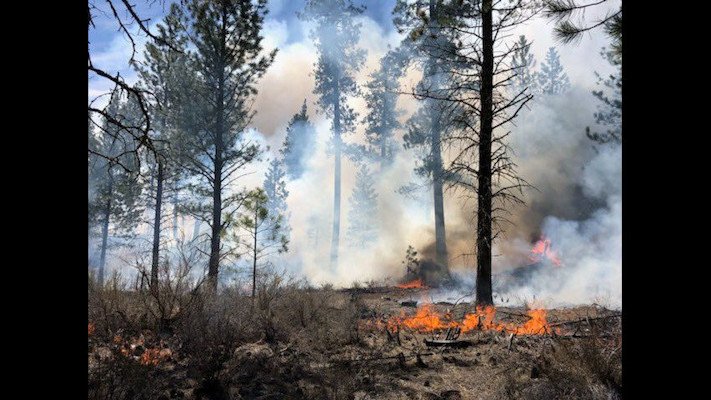Deschutes Natl. Forest west of Bend chosen as pilot project for federal-state collaboration to increase prescribed burns

PORTLAND, Ore. (KTVZ) – State and federal agencies and departments in Oregon and Washington have agreed to collaborate on addressing the escalating wildfire crisis by increasing use of prescribed fire and other forest fuel management strategies at larger geographic scales while also increasing outreach to nearby communities as these strategies are deployed.
And one of the first two pilot projects for this new effort is the West Bend, according to a Forest Service release on Friday, which continues in full below:
These strategies reduce forest fuels on the ground and allow for strategic burning that minimizes community and public health impacts relative to impacts from uncontrolled wildfires.
Over the past decade, wildfires in the Pacific Northwest and beyond have intensified, posing significant risks to human health, particularly among vulnerable communities and populations. These dangers are exacerbated by a warming climate and increased human development in fire-prone areas.
The recent infusion of federal funds through the 2021 Bipartisan Infrastructure Law and the 2022 Inflation Reduction Act has provided an unprecedented opportunity for collective action amongst government agencies.
This collaborative initiative is a response to a March 2023 Government Accountability Office report which emphasized the need for aligned air quality and land management goals to mitigate wildfire risks effectively. Building on a national Memorandum of Understanding and recognizing the public health crisis that wildfires represent, this joint statement outlines a commitment to regional collaboration for achieving these critical goals.
At a meeting last November, representatives from federal and state agencies discussed the necessity of increasing prescribed fire activities.
Prescribed fires or burning areas intentionally to manage land and resource objectives, are deemed essential for reducing wildfire risks and enhancing ecosystem resilience. This approach is balanced with strategies to minimize public health impacts from smoke, emphasizing the need for comprehensive community engagement and support for vulnerable populations.
The principles guiding this initiative include acting with urgency, protecting public health and property, overcoming implementation barriers, embracing innovation, and learning from experience. The agencies aim to leverage expertise, resources, and innovative strategies to increase the scale of prescribed fire implementations while ensuring public health protection.
Two pilot projects, one west of Bend and another in north-central Washington, will serve as initial test areas for these collaborative efforts. The insights gained from these pilot projects will inform further actions and strategies, demonstrating a united front in addressing wildfire and smoke management challenges.
“In the face of a growing wildfire crisis, it's more critical than ever that we come together and leverage every tool, insight, and innovation," said Jacque Buchanan, Regional Forester for the Pacific Northwest Region of the Forest Service.
"This collaboration represents the beginning of a multi-agency effort towards improved cooperation and scale-up of prescribed fire and smoke management, with recognition that a near-term step will be to engage others, particularly Tribes, that are critical to this effort.
"Together, we're committed to reducing wildfire risk and prioritizing the health and safety of our communities while increasing the resilience of our ecosystems. Our shared efforts with these pilot projects will lay the groundwork for a safer, healthier future for the Pacific Northwest.”
Other leadership perspectives:
EPA Region 10 – “Every community across the Pacific Northwest is experiencing the impacts of a longer, smokier wildfire season. One of the best tools we have for making our forests more resilient against catastrophic wildfires is controlled burning,” said EPA Region 10 Administrator Casey Sixkiller. “These prescribed fires target hazardous fuels and allow for healthier forests. The agreement we’re announcing today will help to ensure federal and state agencies are working together and utilizing the best available science to identify where and when prescribed fires will occur, bringing local communities into the conversation, and importantly providing resources to residents so that they can prepare for smoke and have access to clean indoor air.”
Washington State Department of Health – “With increasing wildfires in Washington, prescribed burning is a part of our future. We need people to be ready and to have access to cleaner air spaces. Achieving this broadly across the public will take efforts at every level,” said Laura Johnson, Director, Office of Environmental Public Health Sciences, Washington State Department of Health.
The Joint Statement was signed by the USDA Forest Service, Region 6; U.S. Environmental Protection Agency, Region 10; Oregon Department of Environmental Quality; Oregon Department of Forestry; Oregon Health Authority; Washington State Department of Ecology; Washington State Department of Health; and Washington Department of Natural Resources. It is available for download here.